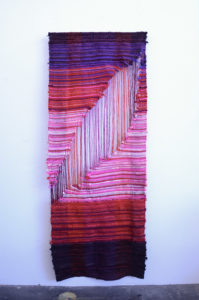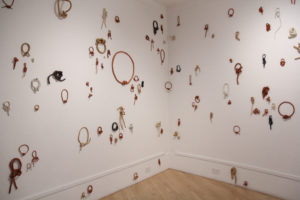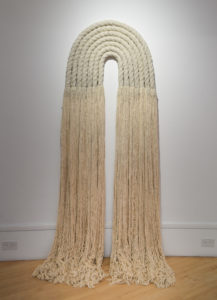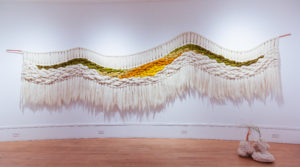
Meet the artists featured in the exhibition, A Beautiful Mess: Weavers and Knotters of the Vanguard, organized by the Bedford Gallery at the Lesher Center for the Arts in Walnut Creek, CA. This week we will highlight four of the artists on display. These artists push the boundaries of fiber art, infusing their works with personal stories and socio-political concerns to further revolutionize the previously marginalized artistic genre.
dani lopez
Oakland, CA

dani lopez, tell me that love isn’t true, 2019, handwoven cotton and hand-cut novelty fabrics, 88 x 36 x 3 in.
dani lopez is a textiles artist working within weaving and fiber sculpture to explore queer desire, femininity, and femme identity. She received her MFA in Textiles from CCA and her BFA from the University of Oregon. Weaving at the loom, sewing, and embroidery act as a portal site to reimagine her closeted queer youth into an out loud one. Materiality plays a large role and these objects flirt with a campy, sad aesthetic. Textiles are a site of regret and redemption for her. The physical, time-intensive processes are where she examines regret and the works that emerge are an act of reimagining and redemption. Pop music, lesbian bars, camp, and pop culture serve as research for her practice. At CCA, she was awarded two teaching assistantships and received a diversity and merit scholarship. She has been featured in Hyperallergic and Other People’s Pixels. lopez has shown at Minnesota Street Project, Tropical Contemporary, Amos Eno Gallery, Patterson-Appleton Arts Center, and the Frank Ratchye Project Space. After spending most of her life in Oregon and trying to leave, she now lives in Oakland with her cat, Trent.
Hannah Perrine Mode
Providence, RI

Hannah Perrine Mode, Rope Team, 2018-2020, unglazed ceramic & video, dimensions variable
Hannah Perrine Mode is an interdisciplinary artist and educator working at the confluence of art, storytelling, and environmental science. Often incorporating place-based making and participatory projects, her objects and installations serve as proxies for climate change, Earth systems, deep time, and human connection. She teaches art as a tool for creative thinking, communication, and outreach – deepening our connection to geologic forces and fostering an intersectional approach to climate justice.
In addition to teaching in collegiate, museum, and other institutional settings, Hannah has collaborated with environmental science and outdoor organizations around the world. She serves as faculty on the leadership team of the Juneau Icefield Research Program in Southeast Alaska, and was a Visiting Artist with the International Arctic Science Committee in Iceland and Chulengo Expeditions in Patagonia. Hannah has been an Artist-in-Residence with Google, the National Park Service/Parks Canada, Alaska State Parks, Vermont Studio Center, and Central Michigan University. She has exhibited her work at venues around the country, including recent shows with the Anchorage Museum in Alaska, Bedford Gallery in Walnut Creek, CA, and SPARC in Los Angeles, CA. She is a co-founder of Erratics, a collaborative research group exploring geologic and human intimacy.
She recently relocated from the California Bay Area to Providence, RI, and usually spends her summers teaching, researching, and making art in Alaska.
Artist Statement
Working across mediums, and often drawing upon scientific research, I use the Earth as both material and subject for storytelling. I make art that incorporates time-based processes and transformative, site-specific materials, like cyanotype, ice, and clay, tapping into their aesthetics as well as their utility. Experimental photographs, automatic paintings, and sculptural installations serve as proxies to document the passage of time, personal experience, and human interaction with our environment.
I am interested in ways to bring the vastness of geologic time to an intimate human scale, and how to make space for vulnerability and connection within that juxtaposition. I write love letters to glaciers, create and tend to systems of melt and erosion, trace my body along fault lines, and imagine new constellation shapes. I collaborate with kindred creative minds to explore geology, empathy, and storytelling, finding permeable borders and fluid exchange between art and scientific study. Whether performed socially or in solitude, each gesture is an exercise in generosity, hope, and (sometimes) futility; an attempt to reimagine the flow of the future.
Liz Robb
Los Angeles, CA

Liz Robb, Passage II, 2021, cotton, grout, 84 x 45 x 19 in.
Liz Robb’s art practice focuses on soft sculpture. Based in Los Angeles, she works sculpturally to create textured surfaces and forms with natural materials such as wool, cotton, jute, and indigo. She captures a moment in time using weaving, wrapping, compressing, structuring, ordering, and releasing processes that become meditations. The repetition of these activities fosters a connection between her subconscious mind and body. Full body rhythmic movements allow her stream of consciousness to expand on certain conceptual ideas and develop more thoughtful conclusions.
Analyzing the work of other artists is also a part of Robb’s process. She is most interested in investigating the ways grid forms manifest through a handheld process that utilizes content and medium. This analysis has been a consistent thread throughout her work.
Robb completed her BFA in Fashion Design at the University of Cincinnati and her MFA in Fibers at the Savannah College of Art and Design. She has exhibited her work both nationally and internationally, and has most recently completed a residency at the Houston Center for Contemporary Craft.
Meghan Shimek
Oakland, CA

Meghan Shimek, Expand with me, 2021, wool, copper, 64 x 226 x 7 in.
Based in Oakland, California, fiber artist Meghan Shimek creates large scale woven wall hangings and sculptures. Her engaging work is ethereal, whimsical and delicate, but rooted in the warm, earthy materials she uses. Exploring organic movement, Shimek’s weaving style allows the fibers to fall into an indeterminate pattern that reveals the beauty and vulnerability of her materials.
Shimek was raised in Michigan and studied history and nutrition before discovering her true passion in weaving. Since dedicating herself fully to fiber work, she has studied tapestry and Navajo weaving, rigid heddle and floor loom weaving. Shimek developed her own signature weaving style over several years as she explored how art can be used to express grief and heal after personal loss. Today, Shimek exhibits her work, creates commissions, and teaches weaving workshops across the world.

